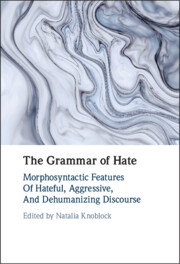Book contents
- The Grammar of Hate
- The Grammar of Hate
- Copyright page
- Contents
- Figures
- Tables
- Contributors
- Acknowledgments
- Introduction
- 1 Animacy and Countability of Slurs
- 2 Language Aggression in English Slang: The Case of the -o Suffix
- 3 Adj+ie/y Nominalizations in Contemporary English
- 4 Grammatical Gender and Offensiveness in Modern Greek Slang Vocabulary
- 5 Unseen Gender
- 6 The Neutering Neuter
- 7 Neutering Unpopular Politicians
- 8 The Power of a Pronoun
- 9 Is Play on Words Fair Play or Dirty Play?
- 10 Expressive German Adjective and Noun Compounds in Aggressive Discourse
- 11 ‘Kill the Invaders’
- 12 ‘I am no racist but …’
- 13 Homophobic Space–Times
- Index
- References
12 - ‘I am no racist but …’
A Corpus-Based Analysis of Xenophobic Hate Speech Constructions in Danish and German Social Media Discourse
Published online by Cambridge University Press: 30 June 2022
- The Grammar of Hate
- The Grammar of Hate
- Copyright page
- Contents
- Figures
- Tables
- Contributors
- Acknowledgments
- Introduction
- 1 Animacy and Countability of Slurs
- 2 Language Aggression in English Slang: The Case of the -o Suffix
- 3 Adj+ie/y Nominalizations in Contemporary English
- 4 Grammatical Gender and Offensiveness in Modern Greek Slang Vocabulary
- 5 Unseen Gender
- 6 The Neutering Neuter
- 7 Neutering Unpopular Politicians
- 8 The Power of a Pronoun
- 9 Is Play on Words Fair Play or Dirty Play?
- 10 Expressive German Adjective and Noun Compounds in Aggressive Discourse
- 11 ‘Kill the Invaders’
- 12 ‘I am no racist but …’
- 13 Homophobic Space–Times
- Index
- References
Summary
The chapter discusses corpus–linguistic challenges and possibilities involved in exploring Hate Speech linked to different constructions in Danish and German. Compiled especially for the XPEROHS–project, grammatically and semantically annotated corpora of Danish and German Twitter and Facebook posts enable qualitative and quantitative exploration of individual word forms or lexemes as well as constructions, understood as conventionalized, non–compositional form-meaning pairings. The chapter illustrates and explains various corpus–linguistic strategies applied to the XPEROHS–corpora and presents their results. Furthermore, we discuss prominent grammatical constructions used to denigrate certain groups like foreigners or Muslims in German and Danish. These include, for example, the I am no racist but… construction, which only superficially signals a balanced standpoint using a highly formulaic introductory phrase. Another construction that works similarly in German and Danish is the alleged (+ ADJ) + NOUN–construction (as in the alleged refugees) in which the adjective supposedly reverses the meaning of the noun. However, though closely related, the two languages do not share all constructions. This is exemplified by the German oh–so + ADJ + NOUN–construction (as in the oh-so-peaceful Muslims), that negates a positive characteristic indicated by the adjective in an ironic way.
Keywords
- Type
- Chapter
- Information
- The Grammar of HateMorphosyntactic Features of Hateful, Aggressive, and Dehumanizing Discourse, pp. 241 - 261Publisher: Cambridge University PressPrint publication year: 2022
References
- 7
- Cited by



